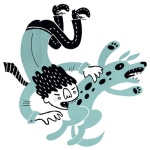In the previous blog posts here and here, we learned that in the Diyari language there many ways to say “this” and “that” depending on what you are talking about or who you are talking to. These are the words we looked at:
| nhaniya | ‘this one (female)’ |
| nhawuya | ‘this one (not female)’ |
| nhaniwa | ‘that one (female)’ |
| nhawuwa | ‘that one (not female)’ |
| pulaya | ‘these two’ |
| pulawa | ‘those two’ |
| thanaya | ‘these three or more’ |
| thanawa | ‘those three or more’ |
Listed above are the basic terms that we use in sentences like ‘… is me’ or ‘… is going’. In other contexts, different terms are used, built upon these basic terms. Here is the full set that is found in Diyari (see my Grammar of Diyari for more details — it is free to download here).
For “this” and “these”:
| Function | this one female | this one not female | these two | these three or more |
| active subject | nhandruya | nhuluya | pulaliya | thanaliya |
| object | nhanhaya | nhinhaya | pulanhaya | thananhaya |
| possessor | nhangkarniya | nhungkarniya | pularniya | thanarniya |
| with, to | nhangkanguya | nhungkanguya | pulanguya | thananguya |
| from | nhangkangundruya | nhungkangundruya | pulangundruya | thanangundruya |
For “that” and “those”:
| Function | that one female | that one not female | those two | those three or more |
| active subject | nhandruwa | nhuluwa | pulaliwa | thanaliwa |
| object | nhanhawa | nhinhawa | pulanhawa | thananhawa |
| possessor | nhangkarniwa | nhungkarniwa | pularniwa | thanarniwa |
| with, to | nhangkanguwa | nhungkanguwa | pulanguwa | thananguwa |
| from | nhangkangundruwa | nhungkangundruwa | pulangundruwa | thanangundruwa |
Here are some examples of these various terms:
nhandruya mankarrali pulanhawa kanku nhayirna warayi This girl saw those two boys
nhaniwa widlha yathayi thananguya pinarranhi That woman is talking to these three or more old men
pulaya kupa thanarniwa walypalaya mindrirna warayi nhungkangundruwa ngurandru These two children belonging to those three or more white people ran away from that camp
This system might look complicated when we list out all the different terms, but with some practice you will be able to understand and use them all in their correct context.




 In today’s post we learn how to say “no” in Diyari.
In today’s post we learn how to say “no” in Diyari.


